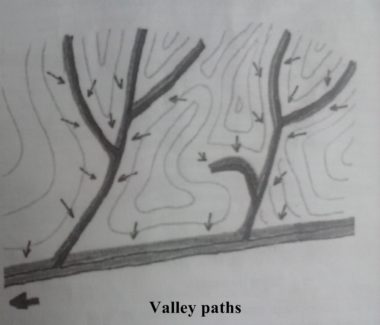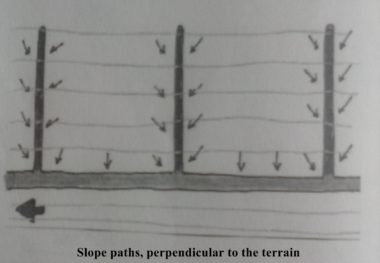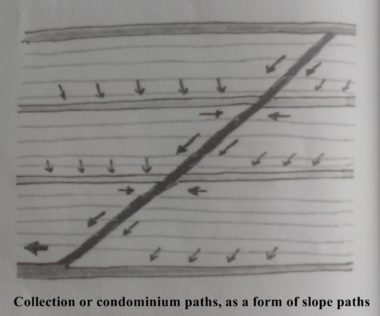
Tractor paths are separated from the truck roads and develop further in depth the forest. At or near the junction of the tractor path from truck road, there is a warehouse. As a rule, for each department which make regular logging must have access to a truck road. Network tractor paths even more dependent on field conditions in comparison with truck roads. Network tractor paths should be laid so that the tractor, without coming down with a tractor path, can pick up all the wood that is marked and felled in a single unit.
Compared to distinguish surface: clay, corrugated and coated.
In relation of the terrain configuration, there are several typical forms of network of tractor paths.
On the flat terrain (slope <10%) applies a schematic arrangement of tractor paths, usually in the form of a network of rectangles and squares.
In the hilly and mountainous terrain, tractor paths schedule may be different, where there are three basic types:
- valley paths
- slope paths
- ridge paths

Valley paths
In the valleys of the rivers and streams are being developed valley paths. They represent basic transport lines that follow the main watercourses. They are usually separate of side branch that accompany tributaries. If the ditches slopes that are separated from the stream the eroded enough, then the branches, which is in the form of the eroded ditches separated from the valley road is very favorable and profitable.

Slope paths
Slope paths on terrains of which the slope does not exceed 25%, are usually the main water line falls, perpendicular to the contour lines. In this case there is no excavation work. Works on the construction of paths are reduced to cleaning the route from trees and stumps, boulders and eventually the larger stone.

When construction costs sufficiently dense network of parent paths become economically unacceptable, resorting to the introduction of collection or condominium paths. These paths are laid in parallel with contour lines or slightly sloped toward parent paths for better draining.
Unfavorable moments of this decision is reflected in the increasing distance of draw near and problems with the cargo in places where the diagonal and condominium paths intersect at a sharp angle.

On the grounds of inclination of 25% – 35% tractor can still be moving on the rise perpendicular to the contour lines during favorable weather conditions when the surface is dry and hard. In the case of wet weather and precipitation, problems may occur due to slipping. To avoid this, paths is laid diagonally contour lines.
On the terrain slope from 35% – 60% construction tractor path is a demanding construction project, especially when it comes to deep soils susceptible to erosion and sliding. In such cases usually resort to the construction of a small number of relatively long diagonal paths, which provide high-altitude development of the route, while the lateral development provides wired lines.

Slope of 60% is the upper limit of feasibility of the construction of tractor paths. In this slope, with tractor paths whose planum 2.60 m wide, about 73% of the formation has to come to firmly, natural soil, while a relatively narrow part of the road comes to a moderate embankment.
Ridge paths
Ridge paths have significantly less importance to open the forest slope than the slope paths, but may be useful in cases where the broad ridge covered with trees. Ridge paths, as a rule lying on hard surfaces. On the ridge paths tree usually draw near winches and wire-rope portable devices. Parts of the route ridge paths with small inclinations, may also be used for truck traffic.

